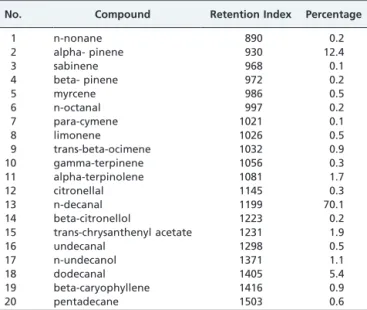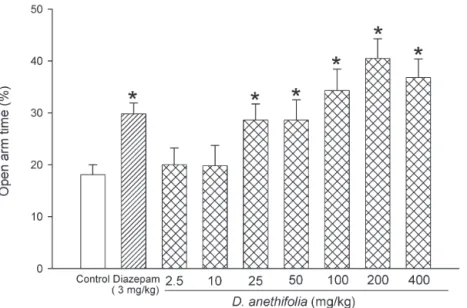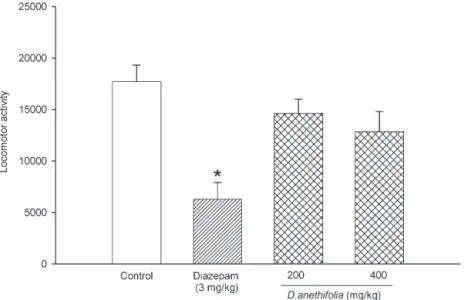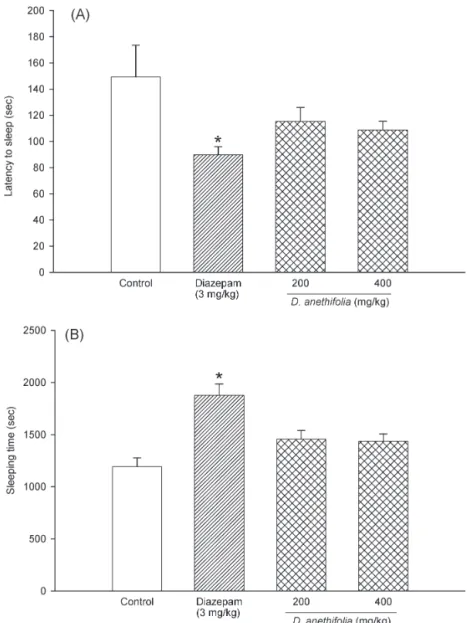BASIC RESEARCH
Evaluation of antianxiety and sedative effects of
essential oil of
Ducrosia anethifolia
in mice
Valiollah Hajhashemi,IMohammad Rabbani,II Alireza Ghanadi,IIIElahe DavariII
IIsfahan Pharmaceutical Sciences Research Center, School of Pharmacy and Pharmaceutical Sciences, Isfahan University of Medical Sciences, Isfahan, Iran. IIDepartment of Pharmacology, School of Pharmacy and Pharmaceutical Sciences, Isfahan University of Medical Sciences, Isfahan, Iran.IIIDepartment of
Pharmacognosy, School of Pharmacy and Pharmaceutical Sciences, Isfahan University of Medical Sciences, Isfahan, Iran.
INTRODUCTION:We investigated the antianxiety and sedative effects of the essential oil of Ducrosia anethifolia. Boiss. (Apiaceae).
METHODS:We used elevated plus maze, spontaneous motor activity and ketamine-induced sleep tests in mice. In addition, the essential oil was analyzed by GC/MS. Twenty compounds were identified, and n-decanal (70.1%) and alpha-pinene (12.4%) constituted the major components.
RESULTS: In elevated plus maze, Ducrosia anethifolia essential oil at doses of 25–200 mg/kg increased the
percentage of open arm time and entries. Unlike diazepam,ducrosia anethifoliaessential oil could not suppress spontaneous motor activity and did not alter ketamine-induced sleep parameters. These results are indicative of antianxiety effect ofDucrosia anethifoliaessential oil without sedative effect.
KEYWORDS: Apiaceae; diazepam; elevated plus-maze; ketamine; spontaneous motor activity.
Hajhashemi V, Rabbani M, Ghannadi A, Davari E. Evaluation of antianxiety and sedative effects of essential oil ofDucrosia anethifoliain mice. Clinics. 2010;65(10):1037-1042.
Received for publication onMay 30, 2010;First review completed onJune 18, 2010;Accepted for publication onJuly 10, 2010
E-mail: vhajhashemi@gmail.com
Tel.:+98 311 7922630
INTRODUCTION
There are many medicinal plants that have stimulating or calmative effects on the central nervous system,1 and the plant kingdom provides hundreds of CNS active substances covering the whole spectrum of activity such as psycho-analeptic, psycholeptic, and psychodysleptic (hallucino-genic) effects.2
Ducrosia anethifolia(DC.) Boiss. is one of these medicinal plants that belongs to the Apiaceae family. It is one of the three species of Iranian Ducrosia species growing wild in several areas of the country.3-5 This aromatic herb is
distributed in Afghanistan, Pakistan, Syria, Lebanon, Iraq, and some other Arab states and countries along the Persian Gulf.5D. anethifoliais commonly known in Iran as Moshgak, Roshgak, and Moshkbu.3-5 The whole herb – especially its
aerial parts – has been used in Iranian folklore medicine as an analgesic and pain reliever for headache, backache, colic, and colds. In some regions of Iran, it is claimed to be especially effective against anxiety and insomnia. This herb is added to a variety of Persian foods for flavoring.3,6
In pharmacological and biological tests, extracts and fractions of D. anethifoliaand some other species of Ducro-sia are reported to have antimicrobial, antimycobacterial,
antifungal, and CNS depressant effects.7-9 Phytochemical studies onD. anethifoliareveal that aliphatic aldehydes and other monoterpene hydrocarbons in its essential oil, and coumarins such as pangelin are the main components of the aerial parts.6,8-10 A few reports on the analysis of the
essential oil of otherDucrosiaspecies have been published, and these species contain some similar biologically active compounds.7,11-12
The present study was carried out in an attempt to inves-tigate the potential anxiolytic and sedative effects of D. anethifolia essential oil, as an outstanding fraction of the plant, in mice using elevated plus maze (EPM), spontaneous motor activity, and ketamine-induced sleep tests. In addi-tion, we describe the essential oil constituents identified by GC/MS analysis, because knowledge of the chemical com-position of a given plant is required in order to extrapolate the proposed mechanism of actions to its possible in vivo
efficacy or safety.13
MATERIALS AND METHODS
Plant material and preparation of essential oil Fresh aerial parts (leaves and flowers) of D. anethifolia, growing wild in Lalehzar mountainous area in Kerman province, Iran, were collected at an altitude of ca. 2800 m. The plant’s identity asD. anethifoliawas confirmed by the herbarium department of Iranian Research Institute of Forests and Rangelands, Karaj, Iran. A voucher specimen of the plant was deposited in the herbarium of School of
Pharmacy and Pharmaceutical Sciences, Isfahan University of Medical Sciences, Isfahan, Iran, for future evidence.
The essential oil was isolated by hydrodistillation of the plant’s fresh-cut aerial parts for 4 h, and then was dried over anhydrous sodium sulfate14and stored in a refrigerator (4
˚
C).Essential oil analysis
The oil was analyzed by GC/MS using a Hewlett Packard 6890 mass selective detector coupled with a Hewlett Packard 6890 gas chromatograph, equipped with a cross-linked 5% PH ME siloxane HP-5MS capillary column (30 m 60.25 mm, film thickness 0.25mm). Operating conditions were as follows: carrier gas, helium with a flow rate of 2 ml/min; column temperature, 60–275
˚
C at 4˚
C/min; injec-tor and detecinjec-tor temperatures, 280˚
C; volume injected, 0.1mL of the oil; split ratio, 150. The MS operating para-meters were as follows: ionization potential, 70 ev; ioniza-tion current, 2 A; ion source temperature, 200˚
C; resolution, 1000.Identification of the components in the oil was based on retention indices relative ton-alkanes and computer match-ing with the WILEY 275.L library, as well as by comparison of the fragmentation patterns of the mass spectra with those reported in the literature.15,16
Elevated plus-maze
The EPM test is described in detail elsewhere.17,18Briefly, the apparatus was comprised of two open arms (35 cm6 5 cm) and two closed arms (30 cm6 5 cm615 cm) that extended from a common central platform (5 cm65 cm). The floor and the walls of each arm were wooden and painted black. The entire maze was elevated to a height of 60cm above floor level as validated and described by Lister.19Experiments were conducted in a quiet room that
was illuminated by only a dim light. Male Swiss mice were orally pretreated with vehicle or different doses of the essential oil 30 min before their placement on the EPM. A group of animals received diazepam (3 mg/kg, p.o.) as reference drug. To begin a test session, mice were placed in the center of the maze facing one of the open arms. An entry into an arm was defined as the animal placing all four paws over the line marking that area. The number of entries and the time spent in the open and closed arms were recorded during a 5 min test period. The percentage of open arm entries (1006open/total entries) was calculated for each animal. Between each trial, the maze was wiped clean with a damp sponge and dried with paper towels.
Locomotor activity
Spontaneous locomotor activity was measured using the locomotor activity apparatus, which consisted of a black painted wooden cage (60 cm6 20 cm630 cm) equipped with infrared photobeams placed above the cage.20 The
units of the activity counts were arbitrary and based on the beam breaks by movement of the mice. Vehicle, DAEO (200 and 400 mg/kg) or diazepam (3 mg/kg), was orally admi-nistered 30 min prior to placing the mice in the center of the apparatus, and the locomotor activity was measured at 5 min interval for a period of 15 min. Six mice were used for each treatment group. The treatments were randomized throughout the day, between 08:00 and 13:00 h, to control for diurnal variations in activity.
Ketamine-induced sleeping time
The effect of plant essential oil on ketamine-induced sleeping time was measured as described previously.21Four
groups of mice (n = 6) were orally pretreated with vehicle, DAEO (200 and 400 mg/kg) or diazepam (3 mg/kg) one hour prior to ketamine injection (100 mg/kg, i.p.). The interval between the administrations of ketamine until the loss of the righting reflex was recorded as onset of sleep, while the time from the loss to regaining of the righting reflex was recorded as the duration of sleep.22
Acute toxicity test
To obtain an estimate of lethal dose, two groups of normal healthy male mice, each containing 6 animals, were given DAEO at doses of 1600 and 2400 mg/kg. After the admi-nistration of the DAEO, the mice were observed for any signs of toxicity and mortality for 48 h.
Statistical analysis
Statistical analysis was performed using one-way analysis of variance (ANOVA) with post hoc Tukey test.P , 0.05 was considered significant. All data are expressed as mean
¡S.E.M.
RESULTS
Analysis of the essential oil
The fresh aerial parts of the plant yielded 1.4% (v/w) of a yellowish essential oil with a fresh-scented odor and a predominant aromatic taste. Twenty components were characterized, representing 98.1% of the total oil compo-nents detected, which are listed in Table 1 with their percen-tage composition and retention indices. Among them, n-decanal (70.1%), alpha-pinene (12.4%), and dodecanal (5.4%) were the major components. Other natural constitu-ents formed less than 2% of the total or were present only in trace amounts.
Table 1 –Composition of the essential oil of ducrosia anethifolia fresh aerial parts.
No. Compound Retention Index Percentage
1 n-nonane 890 0.2
2 alpha- pinene 930 12.4
3 sabinene 968 0.1
4 beta- pinene 972 0.2
5 myrcene 986 0.5
6 n-octanal 997 0.2
7 para-cymene 1021 0.1
8 limonene 1026 0.5
9 trans-beta-ocimene 1032 0.9
10 gamma-terpinene 1056 0.3
11 alpha-terpinolene 1081 1.7
12 citronellal 1145 0.3
13 n-decanal 1199 70.1
14 beta-citronellol 1223 0.2
15 trans-chrysanthenyl acetate 1231 1.9
16 undecanal 1298 0.5
17 n-undecanol 1371 1.1
18 dodecanal 1405 5.4
19 beta-caryophyllene 1416 0.9
20 pentadecane 1503 0.6
Antianxiety effects ofDucrosia anethifolia
Effects ofDucrosia anethifolia essential oil in EPM
test
Various doses of DAEO (2.5, 10, 25, 50, 100, 200 and 400 mg/kg) were tested on the EPM. As shown in Figure 1, in control animals, the time spent in the open arms was 18%. DAEO at doses of 2.5 and 5 mg/kg did not produce a significant change of time spent in the open arms, while other doses (25, 50, 100, 200, and 400 mg/kg) significantly (p ,0.05) increased this parameter. Diazepam (3 mg/kg) also significantly (p,0.05) increased the time spent in the open arms by 104% in comparison with the control group (Fig. 1). Effects of DAEO on the percent of open arm entries can be seen in Figure 2. Again, DAEO at doses of 2.5 and 10 mg/kg did not produce a significant change of this parameter. Compared with control group, DAEO at doses of 25, 50, 100, 200, and 400 mg/kg increased the time spent in open arm
entries by 169%, 171%, 286%, 364%, and 229%, respectively. These changes were significant (p,0.05) for doses of 25 to 200 mg/kg. Diazepam also significantly (p,0.05) increa-sed this parameter by 229%.
Effect ofDucrosia anethifolia essential oil on
spontaneous locomotor activity
The effect of treatments on locomotor activity was measured at 5 min intervasl and during a 15 min period using locomotor activity apparatus. Locomotor activity was decreased in animals orally pretreated with DAEO at doses of 200 and 400 mg/kg compared with saline treated con-trols; however, these changes were not statistically signi-ficant (Fig. 3). Administration of diazepam at a dose of 3 mg/kg significantly (p,0.01) suppressed the locomotor activity (Fig. 3).
Figure 1 -Effects of diazepam, saline, and different doses ofD. anethifoliaon the percentage of time spent in the open arms during a
5-minute test in mice. Test compounds were injected 30 minutes prior to the EPM test. Data are presented as mean values (¡S.E.M.). *P,0.05 compared with vehicle-treated control.
Figure 2 -Effects of diazepam, saline, and different doses ofD. anethifoliaextract on percentage entries in the open arms during a
5-minute test in mice. Test compounds were injected 30 5-minutes prior to the EPM test. Data are presented as mean values (¡S.E.M.). *P
Effect ofDucrosia anethifoliaessential oil on
latency to sleep
Vehicle, DAEO or diazepam, was given one hour prior to ketamine injection, and the latency to loss of righting reflex was measured. In control animals, the righting reflex was lost after 149 s of ketamine injection. DAEO at doses of 200 and 400 mg/kg suppressed the latency to sleep by 23% and 27%, respectively, but these changes were not significant. Diazepam (3 mg/kg) as the reference drug significantly (p, 0.01) reduced the latency to sleep by 40% (Fig. 4A).
Effect ofDucrosia anethifoliaessential oil on
sleeping time
Vehicle, DAEO or diazepam, was given one hour prior to ketamine injection and the total sleep time was measured. The mean of total sleep time in control animals was 1192 s. DAEO at doses of 200 and 400 mg/kg increased the keta-mine-induced sleep time by 22% and 20%, respectively. Diazepam produced a significant (p,0.01) increase of sleep time by 57% (Fig. 4B).
Acute toxicity test
DAEO at doses of 1600 and 2400 mg/kg did not affect the vital signs of animals and during a 48-hour observation period did not cause any mortality.
DISCUSSION
A search for medicinal plants is still important and might provide a useful source for therapy and prevention of diseases or, alternatively, as simple dietary adjuncts to existing therapies.23 The aim of the present study was to evaluate the antianxiety effects ofD. anethifoliaessential oil in mice. Different doses of the essential oil were tested on the EPM. Doses of 2.5 and 10 mg/kg were ineffective. The anxiolytic effect started at a dose of 25 mg/kg and increased in the dose range of 50–200 mg/kg. As expected, diazepam as a benzodiazepine drug produced significant increases in the percentage of open arm time and entries into the open
arms. These data are consistent with the results of numerous previous studies, which have shown that diazepam and other benzodiazepines produce significant anxiolytic effects in a variety of anxiolytic screening procedures, inclu-ding elevated plus-maze test procedures.24-26 Benzodiaze-pines mainly exert their antianxiety effects via interaction with gamma-amino-butyric acid (GABA) receptors.27Since DAEO, unlike diazepam, could not affect ketamine-induced sleep time and spontaneous motor activity, it seems that DAEO has a different mechanism of action. In addition to benzodiazepines, buspirone, and antidepressant drugs are commonly used for treating anxiety.27-28 Buspirone has partial agonistic activity at 5HT1A receptors, and tricyclic
antidepressants and selective serotonine reuptake inhibitors inhibit synaptic reuptake of norepinephrine and serotonine to different extents.27 It is not clear which of the above-mentioned mechanisms explains the antianxiety effect of DAEO; further studies are needed to clarify the exact mechanism.
This is the first study that shows an effect of DAEO on the central nervous system. The pharmacological studies on another species ofDucrosia– namelyD. ismaelis– show it to be a highly significant dose-dependent central nervous system depressant with marked neuromuscular blocking actions for its essential oil. Other experiments onD. ismaelis
essential oil show a parasympatholytic activity on smooth muscles and heart.7
According to the results of GC/MS analysis, DAEO consists of about 20 compounds and n-decanal (70.1%) and alpha-pinene (12.4%) were the major components, and these two compounds may have the greatest role in these pharmacological effects. A complete survey of the literature shows that the antianxiety effects of these two compounds has yet to be studied. Satou et al. (2010) have recently described the anxiolytic effect forAlpinia zerumbetessential oil, which also contains alpha-pinene.29 Since this com-pound is commonly found in essential oils of both plants, it may be responsible for a part of the observed effect, although further detailed study is needed to confirm this theory.
Figure 3 - Effects of diazepam, saline, and different doses ofD. anethifolia on spontaneous locomotor activity during a total of
15 minutes. The locomotor activity counts (mean¡S.E.M.) were measured over a 15-minute period, beginning 30 minutes after the administration of saline, diazepam, or different doses ofD. anethifolia. *P,0.01 compared with vehicle-treated control.
Antianxiety effects ofDucrosia anethifolia
In conclusion, DAEO shows antianxiety effect and does not cause sedation – as confirmed by ketamine-induced sleep time and spontaneous motor activity tests – and it may have some advantages when compared with available chemical antianxiety drugs. However, further studies are needed to determine the possible mechanism of actions of DAEO, and their potential for clinical use needs to be demonstrated in clinical trials.
REFERENCE
1. Schulz V, Hansel R, Blumenthal M, Tyler VE. Rational phytotherapy: A reference guide for physicians and pharmacists. Berlin: Springer; 2004. 2. Carlini EA. Plants and central nervous system. Pharmacol Biochem
Behav. 2003;75:501–12.
3. Aynehchi Y. Materia Medica and Iranian medicinal plants. Tehran: Tehran University Publications; 1991.
4. Ghahreman A. Flore De L’Iran. Teheran: Institut de Recherches des Forets et des Paturages; 1993.
5. Mozaffarian V. A dictionary of Iranian plant names. Tehran: Farhang Moaser; 1996.
6. Haghi G, Safaei A, Safari J. Extraction and determination of the main components of the essential oil ofDucrosia anethifoliaby GC and GC/MS. Iranian J Pharm Res. 2004;3(Suppl. 2):275.
7. Al-Meshal IA. Isolation and characterization of a bioactive volatile oil from Ducrosia ismaelis Asch. Res Commun Chem Pathol Pharmacol. 1986;54:129–32.
8. Janssen AM, Scheffer JJ, Baerheim Svendsen A, Aynehchi Y. The essential oil of Ducrosia anethifolia (DC.) Boiss. chemical composition and antimicrobial activity. Pharm Weekbl Sci. 1984;6:157–60.
9. Stavri M, Mathew KT, Bucar F, Gibbons S. Pangelin, an antimycobacter-ial coumarin fromDucrosia anethifolia. Planta Med. 2003;69:956–9. 10. Sefidkon F, Javidtash I. Essential oil composition ofDucrosia anethifolia
(DC.) Boiss. from Iran. J Essent Oil Res. 2002;14:278–9.
11. Al-Meshal IA, Khalifa TI, Hassan MMA. Physico-chemical characte-ristics and spectroscopy ofDucrosia ismaelisoil. Spectrosc Lett. 1985;18: 495-6.
12. Rustaiyan A, Mazloomifar H, Masoudi SH, Aghjani Z. Volatile oil of Ducrosia assadii Alava. and Prangos acaulis (DC.) Bornm. from Iran. J Essent Oil Res. 2006;18:682-4.
13. Minaiyan M, Ghannadi A, Karimzadeh A. Antiulcerogenic effect of ginger (Zingiber officinaleRoscoe) on cysteamine induced duodenal ulcer in rats. Daru. 2006;14:97-101.
14. European Pharmacopoeia Commission, Council of Europe, European pharmacopoeia. Sainte Ruffine: Maisonneuve SA; 1975.
Figure 4 -Effects of diazepam andD. anethifoliaextract on (A) the latency to loss of righting reflex and (B) total sleep time. The interval
15. Adams RP. Identification of essential oil components by gas chromato-graphy/mass spectroscopy. Carol Stream, IL: Allured Publishing Co.; 1995. 16. Sandra P, Bicchi C. Capillary gas chromatography in essential oil
analysis. Heidelberg: Dr. A. Huethig; 1987.
17. Hogg S. A review of the validity and variability of the elevated plus-maze as an animal model of anxiety. Pharmacol Biochem Behav. 1996;54:21–30. 18. Rodgers RJ, Cao BJ, Dalvi A, Holmes A. Animal models of anxiety: An
ethological perspective. Braz J Med Biol Res. 1997;30:289–304. 19. Lister RG. The use of a plus-maze to measure anxiety in the mouse.
Psychopharmacology (Berl). 1987;92:180-5.
20. Rabbani M, Wright EJ, Little HJ. Tolerance to competitive NMDA antagonists, but no cross tolerance with barbiturates. Pharmacol Biochem Behav. 1995;50:9-15.
21. Figallo EM, Wingard LB Jr. Effects of physostigmine, scopolamine, and mecamylamine on the sleeping time induced by ketamine in the rat. Psychopharmacology (Berl). 1979;61:59-62.
22. Rabbani M, Sajjadi SE, Zarei HR. Anxiolytic effects ofStachys lavan-dulifolia Vahl on the elevated plus-maze model of anxiety in mice. J Ethnopharmacol. 2003;89:271-6.
23. Minaiyan M, Ghannadi A, Salehi E. Antiulcerogenic effect of Zataria multiflora Boiss. on cysteamine induced duodenal ulcer in rats. Iranian J Pharm Sci. 2005;1:223-39.
24. Andrews JS, Stephens DN. Drug discrimination models in anxiety and depression. Pharmacol Ther. 1990;47:267-80.
25. Pellow S, File SE. Anxiolytic and anxiogenic drug effects on exploratory activity in an elevated plus-maze: A novel test of anxiety in the rat. Pharmacol Biochem Behav. 1986;24:525-9.
26. Winslow JT, Insel TR. Infant rat separation is a sensitive test for novel anxiolytics. Prog Neuropsychopharmacol Biol Psych. 1991;15: 745-57.
27. Brunton LL, Lazo JS, Parker KL. Goodman & Gilman’s the pharmaco-logical basis of therapeutics. New York: McGraw-Hill; 2006.
28. Schmitt R, Gazalle FK, Lima MS, Cunha A, Souza J, Kapczinski F. The efficacy of antidepressants for generalized anxiety disorder: A systematic review and meta-analysis. Rev Bras Psiquiatr. 2005;27:18-24.
29. Satou T, Murakami S, Matsuura M, Hayashi S, Koike K. Anxiolytic effect and tissue distribution of inhaledAlpinia zerumbetessential oil in mice. Nat Prod Commun. 2010;5:143-6.
Antianxiety effects ofDucrosia anethifolia



